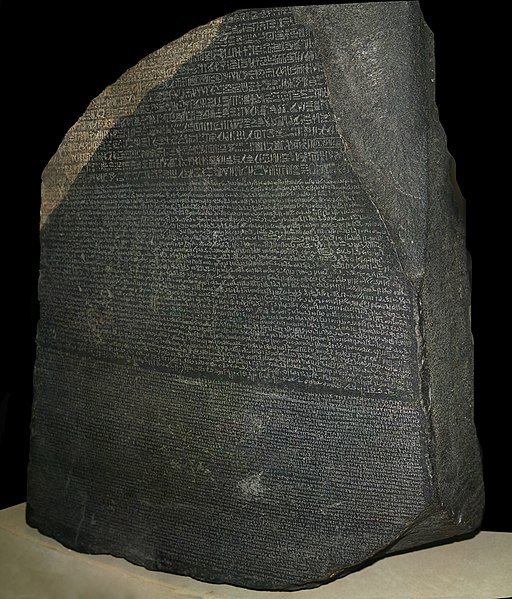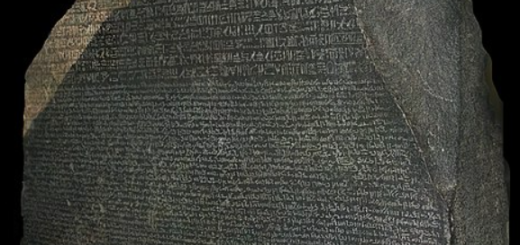Answers to popular questions about the Rosetta Stone

The Rosetta Stone is an ancient artifact of great historical and linguistic significance. It is a granite stele, originally inscribed with a decree issued at Memphis, Egypt in 196 BC during the reign of King Ptolemy V. The decree was written in three scripts: hieroglyphic, demotic (a script used for everyday purposes), and Greek. The Rosetta Stone played a crucial role in deciphering ancient Egyptian hieroglyphs.
Where was the Rosetta Stone “discovered”?
It is generally accepted that archeologists “discovered” the Rosetta Stone at Rashid (Rosetta) in 1799. However, experts claim that the stone probably came from a temple a bit further inland. Some have claimed that the stone likely came from Sais (in present day Gharbia Governorate, Egypt), an ancient Egyptian city in the Western Nile Delta.
The temple where the Rosetta Stone came from was likely shut down around 390 AD, during the reign of Roman Emperor Theodosius I. Known as the Roman ruler who made Catholicism the official state religion, Theodosius (aka Theodosius the Great) closed down a number of non-Christians sanctuaries and temples during his reign (from 379 to 395). The Egyptian temple that contained the Rosetta Stone most likely suffered a similar fate.
Where is the Rosetta Stone housed?
The stone was discovered in July 1799 by French soldiers during Napoleon Bonaparte‘s campaign in Egypt and Syria (1798-1801). After the French surrender, the stone came into the possession of the British under the terms of the Treaty of Alexandria (i.e. the Capitulation of Alexandria in 1801). It is now housed in the British Museum in London, where it has been on display since 1802.
Who deciphered the Rosetta Stone?
There were a number of scholars that helped in the decipherment of the Rosetta Stone. Perhaps the most influential of them was Jean-François Champollion (1790-1832), a French philologist and orientalist.
Champollion is credited with the development of workable ancient Egyptian grammar and hieroglyphic dictionary. Using those tools, scholars could then direct their attention at better understanding the texts on the Rosetta Stone.
Other notable scholars that played leading role in the deciphering of the Rosetta Stele include British polymath Thomas Young and French Classical scholar Antoine-Jean Letronne.

Jean-François Champollion, by French historian and painter Léon Cogniet
What is the significance of the Rosetta Stone?
The significance of the Rosetta Stone lies in the fact that it provided a key to understanding ancient Egyptian hieroglyphs. Scholars were able to compare the Greek text, which they could read, with the hieroglyphic and demotic texts, enabling them to decipher the previously enigmatic hieroglyphic script. This breakthrough opened up a wealth of knowledge about ancient Egyptian civilization and history.
Do all three original texts on the Rosetta Stone convey the same meaning?
In a way, the answer to this question is: it depends. All three languages on the Rosetta Stone basically convey one message: The honoring and deification of Ptolemy V’s rule. However, there exist slight differences between the texts as some interpretations and translations have shown.
Due to those differences, it has made it difficult to have an accurate translation of the scripts into a modern language like English.
Additionally, as our modern understanding of those three texts, especially hieroglyphic texts, continue to increase, the quality and accuracy in translations of the Rosetta Stone text are bound to increase.

Jean-François Champollion’s table of hieroglyphic phonetic characters with their demotic and Greek equivalents, Lettre à M. Dacier, (1822)
Why was the decree made in the first place?
Contrary to traditions in the preceding Pharaonic period, rulers of the Ptolemaic dynasty relied heavily on the decrees and proclamations of Egyptian priests in order to consolidate their rule. This tradition was obviously derived from the ancient Greeks.
In the past Pharaonic eras, Egyptian pharaohs sort of wielded both political and religious power of the land. As a result, there was no need to have a religious body of priests pass out a decree to confirm rulers, who were seen as divine rulers already.
Therefore, the king had his priests at Memphis issue the decree to honor his coronation and his rule over Egypt. The decree, by extension the Rosetta Stele, was meant to deify and exalt the reign of Ptolemy V.
How important was Memphis and the high priests of the city?
In keeping up with Ptolemaic era traditions, the young Ptolemy V had to secure the favor and support of the priests if he was to have a successful and stable reign. This made the high priests of Memphis extremely important and powerful religious figures. For example, despite Alexandria being the capital of Ptolemaic rulers, it was at the temple in Memphis Ptolemy V was crowned.
Where was the Rosetta Stone placed in ancient Egypt?
In the Ptolemaic era, decrees like the Rosetta Stone were often placed in temples across the land. This point is evident in one of the texts of the Rosetta Stone, which issues an order that copies of the stele be placed in every temple in the land.
What does the texts on the Rosetta Stone contain?
In one of the lines on the Rosetta Stele, Ptolemy V is praised for showering gifts upon the temples.
The stone also makes mention of the flooding of the Nile that occurred in the eight year of Ptolemy V’s rule. It praises the king for this occurrence as the flooding of the Nile proved to be very advantageous for the farmers.
The priests of Memphis state in the Rosetta Stone that they would continue to honor the king’s coronation anniversaries as well as the ruler’s birthdays. The priests basically deify Ptolemy V, vowing to worship him as one of the numerous Egyptian deities.

What is the Rosetta Stone made from?
The Rosetta Stone was made from a granodiorite, a type of igneous rock that is characterized by its black or dark gray color. It is composed primarily of plagioclase feldspar, quartz, and smaller amounts of biotite or amphibole minerals. Granodiorite is similar to granite in composition, but with a higher proportion of plagioclase feldspar relative to alkali feldspar.
What was the height of the original stele of the Rosetta Stone?
As stated above, the Rosetta Stone we see today is only a fragment of an even larger stele. Experts and scholars have theorized that – based on parallels drawn to other steles of the Ptolemaic Era – the original stele of the Rosetta Stone was somewhere in the neighborhood of 150 centimeters.
What are some of the most famous replicas of the Rosetta Stone?
In an effort to foster goodwill with Egypt, the British Museum dispatched a life-sized replica of the Rosetta Stone in 2005. Crafted from fiberglass and meticulously color-matched, the replica was sent to Egypt and placed in Rashid. It aimed to provide the local population with a tangible connection to their heritage.
Meanwhile, another notable replica of the Rosetta Stone is housed in the King’s Library within the British Museum in London. This replica serves as a prominent display, allowing visitors to appreciate and engage with the iconic artifact.

Replica of the Rosetta Stone in what was the King’s Library of the British Museum, now the Enlightenment Gallery
Why were three languages used on the Rosetta Stone?
During the Ptolemaic dynasty, Alexandria served as the administrative capital of the land – i.e. the capital of the Ptolemaic rulers. Memphis on the other hand served as the religious capital of Egypt. The city was equally as important, if not more important than Alexandria, to a new Ptolemaic ruler. Without the support of the high priests of Memphis, a Ptolemaic king was bound to have difficulty ruling. This explains why Ptolemy V sought to secure the support of those priests during his reign.
It also explains why the languages used on the Rosetta Stone were three – with the first being hieroglyphics, which was known as the “language of the gods”. The use of Hieroglyphics on top was meant to symbolize the eminence of the script.
The other two language scripts – Demotic and ancient Greek – were used to honor the administrative roots and ancestry of the Ptolemaic rulers. Tracing their roots to Alexander the Great, the Ptolemies were after all of Greek origins.
How did the Rosetta Stone end up being used as a material in the construction of Fort Julien?
Following the onset of the demise of polytheism in the Roman Empire around the late 4th and early 5th centuries, many artifacts and polytheistic temples from the previous civilizations, including ancient Rome and ancient Egypt, were either destroyed or repurposed. Some of the ancient Egyptian temples suffered the fate of being used as raw materials for the construction of new buildings. It is not improbable that the Rosetta Stone ended up being re-used in that manner. This would explain how it ended being used in the construction of an Ottoman era fort – Fort Julien on the bank of the Nile.
How did the Rosetta Stone come to be mistaken as black basalt?
When the Rosetta Stone made its arrival in London, scholars colored the inscriptions with white chalk in order to make those inscriptions more visible. A Brazil wax (i.e. carnauba wax) was placed all over the stone in order to protect it even further. The use of the wax made the stone appear as if it was made of black basalt, a type of volcanic rock that is characterized by its dark black or gray color.
Basalt is formed from solidified lava that has cooled rapidly on the Earth’s surface. Basalt is composed mainly of minerals such as pyroxene, plagioclase feldspar, and olivine. The presence of iron and magnesium-rich minerals gives black basalt its characteristic dark color.
The Rosetta Stone is anything but basalt. Instead, it is a granodiorite. When those wax and chalk sediments were removed from the stone during a cleaning project in 1999, the true dark grey color of the rock was revealed.
Is the Rosetta Stone the only Ptolemaic-era decree found so far?
No. The Rosetta Stone is not the only Ptolemaic era stele containing Egyptian bilingual or trilingual inscriptions. As a matter of fact discoveries have been made of earlier Ptolemaic decrees, including the Decree of Alexandria in 243 BC, the Decree of Canopus in 238 BC, and the Memphis decree of Ptolemy IV around 218 BC.
So, what makes the Rosetta Stone special?
The distinguishing feature of the Rosetta Stone is due to it being an iconic symbol of the study of ancient languages and the unlocking of historical mysteries. It represents a landmark achievement in the field of Egyptology and continues to fascinate visitors with its inscriptions and the story behind its decipherment.
Bibliography
Adkins, Lesley; Adkins, R. A. (2000). The Keys of Egypt: the obsession to decipher Egyptian hieroglyphs. HarperCollins.
Bagnall, R. S.; Derow, P. (2004). The Hellenistic Period: historical sources in translation. Blackwell.
Gillispie, C. C.; Dewachter, M. (1987). Monuments of Egypt: the Napoleonic edition. Princeton University Press
Iversen, Erik (1993) [First edition 1961]. The Myth of Egypt and Its Hieroglyphs in European Tradition. Princeton University Press.
Meyerson, Daniel (2004). The Linguist and the Emperor: Napoleon and Champollion’s quest to decipher the Rosetta Stone. Ballantine Books.
Quirke, Stephen; Andrews, Carol (1989). The Rosetta Stone. Abrams.
Shaw, Ian (2000). The Oxford history of Ancient Egypt. Oxford University Press.
Simpson, R. S. (1996). Demotic Grammar in the Ptolemaic Sacerdotal Decrees. Griffith Institute.
Solé, Robert; Valbelle, Dominique (2002). The Rosetta Stone: the story of the decoding of hieroglyphics. Four Walls Eight Windows.
Wilson, Robert Thomas (1803). History of the British Expedition to Egypt. 4th ed. Military Library.

























